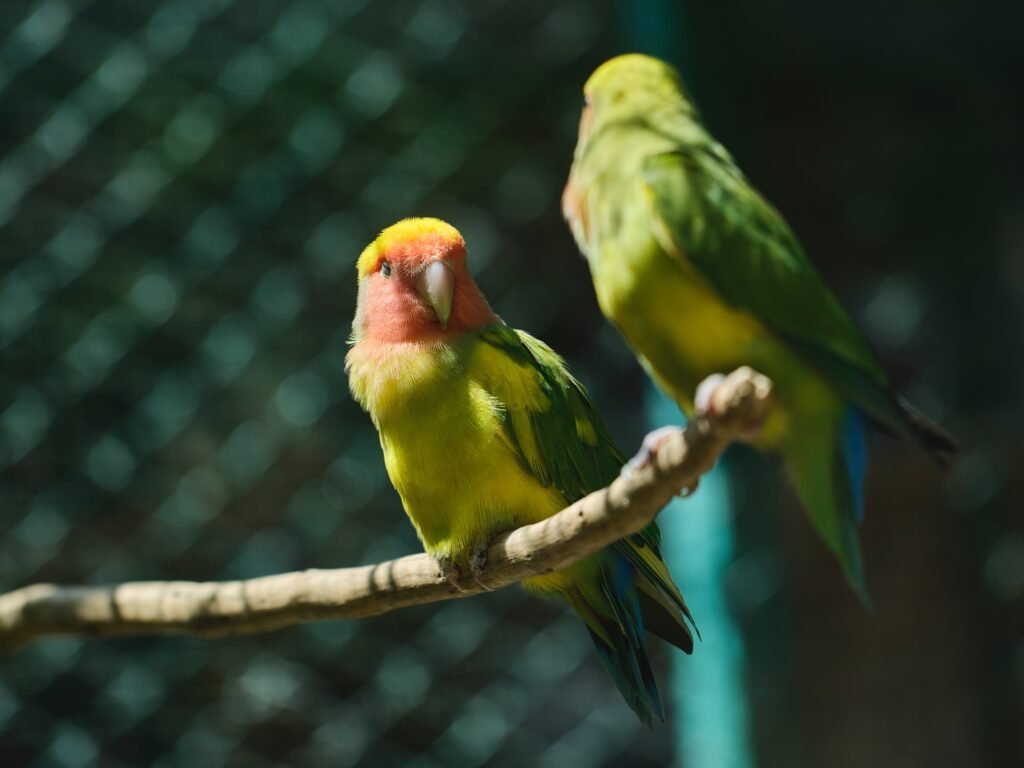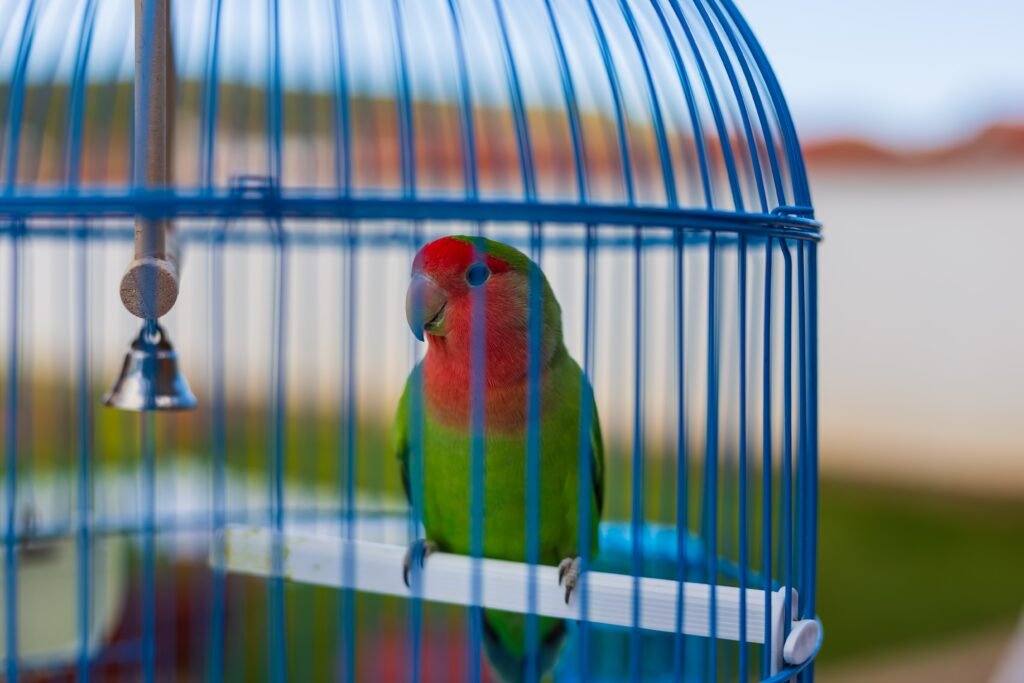Lovebirds, known for their captivating beauty and delightful nature, have become popular pets among bird enthusiasts worldwide. These small parrots are known not only for their vibrant plumage but also for their unique characteristics and charming personalities. This article will explore the fascinating world of lovebirds and uncover the distinctive traits that make them such beloved companions.
Introduction to Lovebirds
Lovebirds, scientifically classified as Agapornis, belong to the parrot family Psittacidae. Native to the African continent, these adorable birds have captured the hearts of many bird lovers due to their affectionate behavior and strong bond with their mates.
Physical Appearance
Lovebirds are small, measuring around 13-17 centimeters long and weighing 40-60 grams. Despite their petite size, lovebirds have an astonishing variety of colors and patterns that are truly breathtaking. From vibrant shades of green, blue, and yellow to beautiful combinations of these hues, each lovebird displays a visually unique plumage. Their feathers are often adorned with intricate markings and patterns, further enhancing their appeal.
Lovebirds come in a variety of color mutations, including:
- Lutino: These lovebirds have yellow plumage with red eyes.
- Pied: Pied lovebirds have a combination of solid and variegated feathers.
- Cinnamon: These lovebirds have a cinnamon-brown coloration.
- Opaline: Opaline lovebirds have a lighter body color and contrasting wing color.
- Albino: Albino lovebirds have a completely white plumage with red eyes.
Social Behavior
One of the most remarkable traits of lovebirds is their strong inclination towards social interaction. As their name suggests, lovebirds form incredibly strong bonds with their chosen mate and demonstrate deep affection towards one another. They are monogamous creatures, often spending hours preening, cuddling, and engaging in playful activities. Their commitment and devotion to their partners are truly awe-inspiring.
Lovebirds also display social behavior within their flock. They communicate through various vocalizations, body language, and physical contact. This social interaction is essential for their well-being and allows them to establish a hierarchy and maintain a sense of community.
Vocalizations
Lovebirds are not known for their ability to mimic human speech like other parrot species, but they possess a rich repertoire of vocalizations. They communicate through chirps, whistles, and various musical sounds. These vocalizations serve as a means of expressing their emotions, establishing their territory, and communicating with their flock members.
Lovebirds have specific calls for different situations, such as:
- Contact Call: Lovebirds use this call to locate and communicate with their mate or flock members.
- Alarm Call: When they sense danger or perceive a threat, lovebirds emit this loud and repetitive call to alert others.
- Contentment Call: Lovebirds make soft and soothing sounds when relaxed and content.
Personality Traits of Lovebirds
Beyond their physical appearance and social behavior, lovebirds possess a range of personality traits that further endear them to bird enthusiasts. Here are some notable characteristics that make lovebirds such captivating pets:
Playfulness and Curiosity
Lovebirds are highly energetic and playful creatures. They love to explore their surroundings, investigate new objects, and engage in interactive play sessions. Their charming nature and inquisitive personalities make them incredibly entertaining companions.
Lovebirds enjoy playing with a variety of toys, such as:
- Swings: Lovebirds love to swing back and forth on a hanging perch, providing them with physical and mental stimulation.
- Chew Toys: Lovebirds have strong beaks and enjoy chewing on toys made of bird-safe materials, such as wood or natural fibers.
- Foraging Toys: These toys encourage lovebirds to search for treats hidden within, stimulating their natural foraging instincts.
Affectionate Nature
Lovebirds are renowned for their affectionate nature towards their mates and even their human caretakers. They enjoy physical contact and often seek out gentle petting, head scratches, and cuddles. They thrive on the attention and love they receive from their owners, forming strong emotional bonds that can last a lifetime.
To build a strong bond with your lovebird, spend quality time together and provide them with affectionate gestures, such as:
- Gentle Petting: Lovebirds enjoy being gently stroked on their head, neck, or back.
- Head Scratches: Lightly scratching their head or neck can provide them with comfort and reassurance.
- Cuddling: Lovebirds appreciate being held close to their owner’s chest, feeling the warmth and security of their presence.
Intelligence and Trainability
Despite their small size, lovebirds possess remarkable intelligence. They are quick learners and can be trained to perform simple tricks and respond to basic commands. Lovebirds can develop impressive skills and showcase their intelligence with patience, positive reinforcement, and a gentle approach.
Some tricks and commands that lovebirds can learn include:
- Target Training: Teaching your lovebird to touch a target stick with its beak.
- Step-up Command: Training your lovebird to step onto your hand or a perch on command.
- Retrieve Training: Teach your lovebird to pick up small objects and return them to you.
Playmates and Companionship
Lovebirds are highly sociable birds and thrive in the presence of their flock members. In addition to their bond with their mate, lovebirds can also form strong connections with their human caregivers. However, it’s important to note that lovebirds are not solitary birds and may become lonely or develop behavioral issues if left alone for extended periods. Providing suitable companionship or spending quality time with them is essential for their well-being.
If you are considering getting a lovebird, having at least two lovebirds is recommended to keep each other company. However, if you can’t have multiple lovebirds, you should dedicate significant time to interacting with your single lovebird.
Caring for Lovebirds
Proper care and attention are crucial to ensure your lovebirds’ health and happiness. Here are some essential tips for providing a nurturing environment for your feathered friends:
- Cage and Environment: Select a spacious cage that allows your lovebirds to move freely and comfortably. Provide perches at different heights and thicknesses, toys of various textures, and objects for them to chew on. These enrichments will keep them mentally and physically active.
- Nutrition: A balanced diet is vital for the well-being of lovebirds. Offer diverse fresh fruits, vegetables, high-quality pellets, and seeds. Lovebirds have specific dietary requirements, so providing a mix of these food groups is important. Avoid feeding them foods toxic to birds, such as avocado and chocolate.
- Hygiene and Cleanliness: Regularly clean the cage, food dishes, and water containers to maintain a hygienic environment. Lovebirds are prone to certain diseases, so ensuring cleanliness is essential for their health. Additionally, they should be provided with fresh water daily and remove uneaten food to prevent contamination.
- Social Interaction: Spend quality time with your lovebirds every day. Engage in interactive play and gentle handling, and provide mental stimulation to keep them happy and emotionally fulfilled. Talk to them, sing to them, and include them in your daily activities to strengthen your bond.
- Veterinary Care: Schedule regular check-ups with an avian veterinarian to monitor your lovebirds’ health. Vaccinations, parasite prevention, and routine examinations are essential to detect and address potential health issues early on. Your veterinarian can also guide specific care requirements based on your lovebirds’ needs.
Conclusion
Lovebirds are truly extraordinary creatures that possess a combination of beauty, charm, and delightful personality traits. Their affectionate nature, intelligence, and social behavior make them captivating companions for bird enthusiasts worldwide. You can build a rewarding and lifelong relationship with these enchanting feathered friends by understanding their unique characteristics and providing them with the love and care they deserve.
This article is written in markdown format.
FAQ
Q1: What is the average size of lovebirds?
A1: Lovebirds are small, measuring around 13-17 centimeters long and weighing 40-60 grams.
Q2: What are some of the color mutations in lovebirds?
A2: Lovebirds have various color mutations, including Lutino, Pied, Cinnamon, Opaline, and Albino.
Q3: How do lovebirds communicate with each other?
A3: Lovebirds communicate through vocalizations, body language, and physical contact. They have specific calls for different situations, such as contact, alarm, and contentment calls.
Q4: Can lovebirds be trained to perform tricks?
A4: Yes, lovebirds are intelligent and can be trained to perform simple tricks and respond to basic commands with patience, positive reinforcement, and a gentle approach.
.


